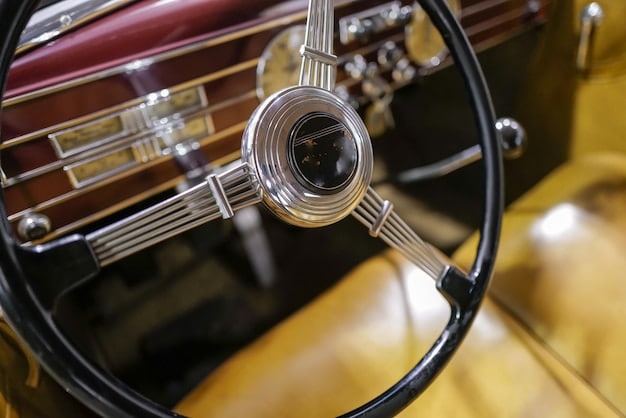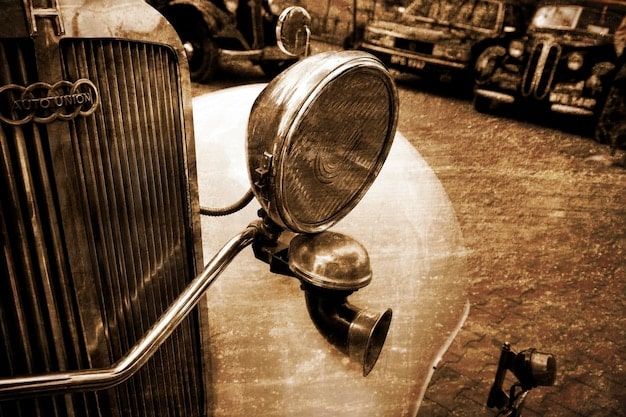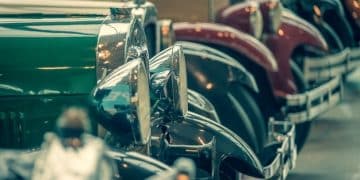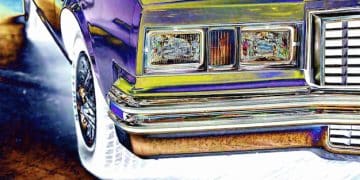The Culture of Automotive Collecting: Building a Dream Car Collection

The culture of automotive collecting involves enthusiasts meticulously building and curating dream car collections, reflecting personal taste, historical significance, and investment potential, within a passionate global community.
The allure of classic cars, the thrill of the auction, and the pride of ownership – welcome to the captivating world of automotive collecting. The culture of automotive collecting: building and curating a dream car collection is more than just acquiring vehicles; it’s a journey through history, a celebration of engineering, and an expression of personal passion.
Understanding the Allure of Automotive Collecting
Automotive collecting isn’t merely about possessing vehicles; it’s a profound connection with history, design, and personal aspiration. Collectors are driven by a multitude of factors, ranging from nostalgia to investment potential.
The allure extends beyond the tangible; it’s about being part of a community, sharing knowledge, and preserving automotive heritage for future generations.
The Emotional Connection
For many, collecting cars is deeply personal. A particular model might evoke memories of childhood, a specific era, or a significant life event. The act of restoring and maintaining these vehicles becomes a labor of love, strengthening the emotional bond.
Investment Potential
While passion often drives the initial purchase, the potential for appreciation is undeniable. Certain classic and rare models can command significant prices at auction, making automotive collecting a viable investment strategy. However, it’s crucial to approach this aspect with caution and informed research.

In essence, automotive collecting is a multifaceted pursuit, blending emotional connection, historical appreciation, and potential investment gains.
Defining Your Automotive Collecting Goals
Before diving into the world of automotive collecting, it’s essential to define your objectives. What are you hoping to achieve? What types of vehicles align with your passion and resources?
A clear roadmap will help you navigate the complexities of the market and build a collection that truly reflects your individual taste and aspirations.
- Niche Focus: Consider specializing in a specific era, marque, or type of vehicle (e.g., pre-war classics, Italian sports cars, muscle cars). This focused approach allows you to develop expertise and potentially uncover hidden gems.
- Budget Determination: Establish a realistic budget to avoid overspending and financial strain. Factor in not only the purchase price but also ongoing maintenance, storage, and insurance costs.
- Long-Term Vision: Determine your long-term goals for the collection. Are you aiming to build a museum-quality display, participate in vintage rallies, or simply enjoy the vehicles privately?
Thoughtful planning is the cornerstone of successful automotive collecting. By defining your goals, you’ll be better equipped to make informed decisions and curate a collection that brings lasting satisfaction.
Navigating the Automotive Market
The automotive market is a dynamic and complex landscape, requiring careful navigation. Understanding the various avenues for acquisition and the factors that influence value is paramount.
From auctions and private sales to online marketplaces and specialized dealers, each option presents unique opportunities and challenges.
Auctions: The Thrill of the Bid
Auctions offer a thrilling environment for acquiring rare and desirable vehicles. However, it’s crucial to conduct thorough research, inspect the vehicle in person or through a trusted expert, and set a maximum bid to avoid impulsive decisions. Reputable auction houses provide detailed condition reports and provenance information.
Private Sales: Building Relationships
Private sales can offer a more intimate and personal experience. Networking with fellow enthusiasts, attending car shows, and joining online forums can lead to valuable connections and potential acquisition opportunities. Due diligence is still essential, including independent inspections and title verification.
- Online Marketplaces: Online platforms provide a convenient way to browse a wide range of vehicles. However, exercise caution and prioritize secure transactions. Always request detailed photos and video evidence before committing to a purchase.
- Specialized Dealers: Reputable dealers specializing in classic and collectible cars can offer expertise, authentication services, and after-sales support. They often have access to a curated inventory and can assist with locating specific models.
Ultimately, navigating the automotive market requires a blend of research, networking, and careful evaluation. By understanding the various options and potential pitfalls, you can confidently pursue your collecting goals.

The Importance of Preservation and Restoration
Preservation and restoration are integral aspects of automotive collecting, ensuring that these historical artifacts endure for future generations. The level of intervention can range from basic maintenance to complete ground-up restorations.
Understanding the ethical considerations and available resources is crucial for maintaining the value and integrity of your collection.
Originality vs. Restoration
The debate between preserving originality and undertaking a full restoration is a central theme in the collecting world. Some collectors prioritize originality, valuing the patina and historical accuracy of an unrestored vehicle. Others opt for restoration to bring the vehicle back to its original glory, often enhancing its value and appeal.
Finding Qualified Specialists
Entrusting your vehicle to qualified specialists is essential for achieving optimal results. Research restoration shops with proven track records, experienced technicians, and a deep understanding of vintage automobiles. Seek recommendations from fellow collectors and prioritize shops that adhere to ethical restoration practices.
Effective preservation and restoration are vital for safeguarding the historical and aesthetic value of automotive treasures.
Building Relationships within the Automotive Community
The automotive collecting world thrives on community. Connecting with fellow enthusiasts, experts, and historians enhances the experience and opens doors to new knowledge and opportunities.
Actively engaging in the community fosters a sense of camaraderie and contributes to the preservation of automotive heritage.
- Car Clubs: Joining car clubs dedicated to specific marques or vehicle types provides access to technical expertise, shared resources, and organized events. Clubs often host rallies, shows, and workshops, fostering a sense of belonging.
- Online Forums: Participating in online forums and social media groups connect you with a global network of enthusiasts. These platforms facilitate discussions, knowledge sharing, and the exchange of information about vehicles, parts, and restoration services.
- Car Shows and Events: Attending car shows and events is a great way to showcase your collection, network with fellow enthusiasts, and learn about new trends and technologies. These events provide a platform for judging, awards, and public appreciation.
Building relationships within the automotive community is not only rewarding but also essential for long-term success and enjoyment.
The Future of Automotive Collecting
The culture of automotive collecting is constantly evolving, shaped by technological advancements, shifting demographics, and emerging trends. Understanding these factors is crucial for anticipating future opportunities and challenges.
From the rise of electric vehicles to the growing interest in online auctions, the landscape is poised for continued transformation.
Embracing Emerging Technologies
New technologies are revolutionizing the way collectors research, acquire, and maintain their vehicles. Online databases, digital restoration tools, and 3D printing are enhancing the accessibility and efficiency of the collecting process. Embracing these advancements will be essential for staying ahead of the curve.
The Next Generation of Collectors
Attracting younger generations to the hobby is vital for ensuring its longevity. Showcasing the cultural and historical significance of automobiles, promoting hands-on restoration activities, and leveraging social media platforms can inspire a new wave of enthusiasts. Fostering a sense of inclusivity and accessibility is key.
The future of automotive collecting promises to be dynamic and exciting. By embracing innovation and fostering inclusivity, the community can ensure that this passion endures for generations to come.
| Key Aspect | Brief Description |
|---|---|
| 🔑 Defining Goals | Establish clear collecting objectives, budget, and long-term vision. |
| 🔎 Market Navigation | Explore auctions, private sales, and specialized dealers with due diligence. |
| 🛠️ Preservation | Prioritize vehicle care, balancing originality and restoration. |
| 👥 Community | Engage with enthusiasts to enrich knowledge and access opportunities. |
FAQ
▼
Generally, a car 20 years or older is often considered a classic, although this can vary by state and insurance company. The car’s historical interest and rarity also play a role.
▼
Factors include condition, rarity, provenance, and market demand. Consult valuation guides, auction results, and appraisals from experts to estimate the car’s worth accurately.
▼
Check for rust, body damage, engine condition, and interior wear. Verify the car’s documentation and ensure that all components are original or properly restored to match original factory specifications.
▼
Maintenance depends on the car’s age and usage. Regular checks on fluids, tires, and mechanical components are essential. Consider storing the car properly during off-seasons to prevent damage.
▼
Specialized parts suppliers, online forums, and car clubs are great resources. Some original manufacturers also still produce or license the production of parts for classic models.
Conclusion
The realm of automotive collecting is a rewarding journey of discovery, preservation, and community. Whether driven by historical appreciation, a passion for design, or investment considerations, building and curating a dream car collection requires careful planning, diligent research, and a deep understanding of the market. As the automotive landscape evolves, staying informed, embracing new technologies, and fostering connections within the community will ensure that this captivating culture thrives for generations to come.





